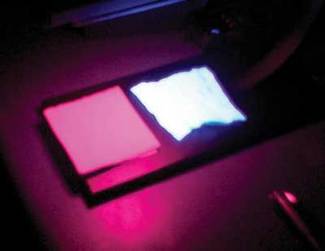



|
FLUORESCENT
WHITENING
AGENTS
IN LAUNDRY DETERGENT
& PAPER
|
| 1:
History 2:Importance and
Usage 3:
Spectroscopy 4: Current
Studies 5:
Future Expts. |
| 6: HS Classroom
Lesson: A: Lesson
Plan B:
Worksheets C: Instructor
Guide |
 4.
Current Studies
4.
Current Studies|
The cost of FWAs increased by 250% in 2008.
|
 Because FWAs have become an integral ingredient in laundry
detergents.
Several studies have used FWAs as a tracer for human wastewater
(7-9).
Since laundry effluent and sanitary wastewater are often mixed
together, FWAs can be ued to approximate the source of untreated runoff
(8), or even be used to ascertain what percentage of fecal coliform
bacteria in a water sample may come from human sources (9).
Since classic fluorimeters are sensitive to the presence of sediments
in the sample cell because of the inevitable light absorption and
scattering, there is also related research on using LEDs to create a
fluorimeter that would be more resistant to the impact of sediments
(10). Figure 1 to the left shows the difference (under a
blacklight) between a cotton pad
untreated with FWAs and a cotton pad that had been placed in a waterway
which contains some domestic runoff.
Because FWAs have become an integral ingredient in laundry
detergents.
Several studies have used FWAs as a tracer for human wastewater
(7-9).
Since laundry effluent and sanitary wastewater are often mixed
together, FWAs can be ued to approximate the source of untreated runoff
(8), or even be used to ascertain what percentage of fecal coliform
bacteria in a water sample may come from human sources (9).
Since classic fluorimeters are sensitive to the presence of sediments
in the sample cell because of the inevitable light absorption and
scattering, there is also related research on using LEDs to create a
fluorimeter that would be more resistant to the impact of sediments
(10). Figure 1 to the left shows the difference (under a
blacklight) between a cotton pad
untreated with FWAs and a cotton pad that had been placed in a waterway
which contains some domestic runoff. WORKS
CITED:
|